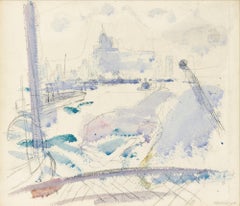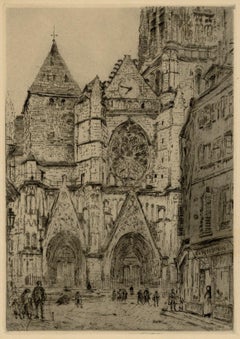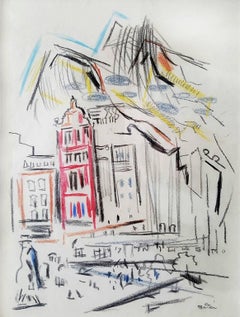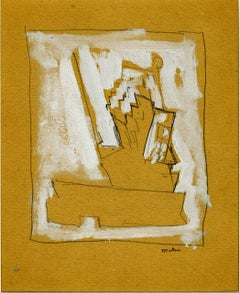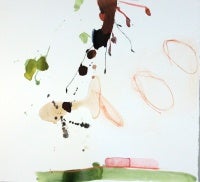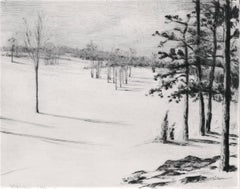John Marin Art
to
1
12
3
5
4
8
1
Overall Height
to
Overall Width
to
5
3
1
7
3
2
2
2
1
1
1
1
1
12
4
3
2
1
12
6,952
3,302
2,514
1,213
9
2
2
1
1
Artist: John Marin
"New York from the Ferry" John Marin, American Modernism Watercolor, Cityscape
By John Marin
Located in New York, NY
John Marin
New York from the Ferry, 1914
Signed and dated lower right
Watercolor and graphite on paper
11 x 12 3/4 inches
Provenance:
An American Place, New York
Kennedy Galleries, Inc., New York
Christie's, New York, March 16, 1990, Lot 278
Private Collection (acquired from the above)
Sotheby's New York, American Paintings, Drawings, & Sculpture, October 2, 2014, Lot 10
A major figure in early twentieth-century modernism, John Marin captured the colliding energies of the American urban scene and the vibrant contrasts of natural elements in the coastal landscape of Maine and other countryside locales. As one of the premier watercolorists of his era, Marin developed a light, spontaneous style ideally suited to conveying the freshness and flux of city and country experience -- his watercolors are often considered to match in strength those created by Winslow Homer in previous century. At the same time, Marin's sensitivity to mass, form, color, and line and their dynamic interchanges provided a precedent for the Abstract Expressionist movement of the late 1950s.
Marin was born in Rutherford, New Jersey, to a family of European descent. After studying mechanical drawing and mathematics for half a year at the Stevens Institute of Technology in New York, Marin worked as a draftsman for several architects. It was not until he was almost thirty years old that he began to study art. He enrolled at the Pennsylvania Academy of the Fine Arts in Philadelphia from 1899 to 1901, and at the Art Students League in New York from 1901 to 1903, where his teachers were William Merritt Chase and Frank Vincent Dumond. While Marin was attending the League, the radical ideas of Arthur Wesley Dow were being disseminated and had an impact on the direction Marin would soon take in his art.
Marin left for Europe in 1905. The next five years, which he spent abroad, were of tremendous importance to his career. He became a significant figure in the expatriate community in Paris, frequenting the Dôme, a café that served as a meeting place for artists and writers. While in Europe, Marin visited the Louvre and the Rijksmuseum in Amsterdam and, despite his claims that he had been indifferent to the Paris art world, he undoubtedly became aware of the art of Paul Cézanne and Henri Matisse. The works Marin created in Europe most strongly reflect the influence of James McNeill Whistler, especially the pastels he rendered in Venice.
In the summer of 1909, Marin met Alfred Stieglitz in Paris. In February of the next year, Marin's work was shown along with that of Alfred Maurer at Stieglitz's gallery, 291. After returning to America in the following year, Marin became one of the most consistent members of Stieglitz's inner circle, showing at all three of his galleries -- 291, The Intimate Gallery, and An American Place. After 1910, Marin developed the routine that he would follow for the rest of his life, creating paintings, drawings, and prints in New York City and surrounding areas during the winter, and in the summer, traveling to the country, where he focused on the particular characteristics of the regions that he visited. He worked mainly in watercolor until 1928, when he began also to use oil.
Marin never became purely abstract. He formulated a unique style melding influences of the art of the French Fauves, Cézanne, Matisse, and the French Cubists with a personal style of luminescent colors, agile brushwork, and a simultaneously delicate and strong handling. In city views, he used broken lines, a light touch, fluid color, and rhythmic compositions to convey what he described as the "great forces at work." He expressed the warring of the great and the small through relationships between masses. As he said, he sought to express the "pull forces" of the modern urban scene. Often portraying the new tall buildings of New York seen...
Category
1910s American Modern John Marin Art
Materials
Paper, Watercolor
Meaux Cathedral II
By John Marin
Located in Middletown, NY
Paris: Gazette de Beaux Arts, 1907. Etching with aquatint on cream wove paper, 8 7/8 x 11 1/2 inches (225 x 292 mm), narrow lefthand margin, with a full margin with a deckle edge on ...
Category
Early 20th Century English School John Marin Art
Materials
Handmade Paper, Etching, Aquatint
Woolworth Building, No. 2
By John Marin
Located in New York, NY
A superb, richly-inked impression of this extremely scarce etching and drypoint. Second state (of 2). Edition of approximately only 10. Signed in pencil by Marin. Published by Alfred...
Category
1910s Modern John Marin Art
Materials
Drypoint, Etching
New York Street Movement and Figure - Architecture
By John Marin
Located in Miami, FL
This work by John Marin depicts an image of lower Manhattan which was Marin's more iconic subject matter. The work has a stellar provenance as well.
Provenance:
Kennedy Galleries
Richard York Gallery
ACA Galleries...
Category
1920s American Modern John Marin Art
Materials
Crayon
John Marin "Clock Tower of Santa Maria Zobenigo, Venice, Italy" Etching c.1907
By John Marin
Located in San Francisco, CA
John Marin "Clock Tower of Santa Maria Zobenigo, Venice, Italy" Original Pencil Signed Etching c.1907
Rare pencil signed etching by listed American artist John Marin (1870-1953)
Pl...
Category
Early 20th Century Impressionist John Marin Art
Materials
Etching
Study for Mid-Manhattan II
By John Marin
Located in Fairlawn, OH
Study for Mid-Manhattan II
Oil and graphite on paper, mounted to board, 1932
Signed by the artist in pencil lower right
Sight size: 8 1/2 x 7 inches
One of a series of studies for th...
Category
1930s American Modern John Marin Art
Materials
Oil
CANAL BRIDGE AMSTERDAM
By John Marin
Located in Santa Monica, CA
JOHN MARIN (1872 -1953)
CANAL BRIDGE AMSTERDAM, 1906 (Zigrosser 13 i/ii)
Etching, drypoint and plate tone. A PROOF IMPRESSION of the 1st state, Annotated...
Category
Early 1900s American Impressionist John Marin Art
Materials
Etching
St. Germain-Des-Pres, Paris
By John Marin
Located in New York, NY
John Marin (1870-1953), St. Germain-Des-Pres, Paris, etching, 1906. Signed in pencil lower right and titled lower left [also signed and dated in the plate]. Zigrosser 47, only state,...
Category
Early 1900s American Impressionist John Marin Art
Materials
Etching
Brooklyn Bridge No. 6 (Swaying)
By John Marin
Located in New York, NY
John Marin (1870-1953), Brooklyn Bridge No. 6 (Swaying), 1913, Etching.
Z112. Edition c. 12 (Steiglitz); 1924, unknown but small (New Republic). Signed in pencil. Signed and dated...
Category
1910s Cubist John Marin Art
Materials
Etching
Quartier de la Maison Blanche
By John Marin
Located in New York, NY
A superb, dark impression of this extremely scarce, early etching on Japan paper. Edition of approximately only 12. Signed and titled in pencil.
Category
Early 1900s American Modern John Marin Art
Materials
Etching
Ponte di Donna Onesta, Venice
By John Marin
Located in Missouri, MO
Very rare etching by John Marin.
"Ponte di Donna Onesta, Venice" 1907
Original Etching
Hand Signed Lower Right
Titled Lower Left
Edition: c. 30
Cat. Rais: ...
Category
Early 1900s Abstract John Marin Art
Materials
Etching
Downtown, The El
By John Marin
Located in New York, NY
John Marin (1870-1953), Downtown, The El, etching, 1921, signed in pencil lower left (also signed and dated in the plate). Reference: Zigrosser 134, only state. Published initially by Alfred Stieglitz and then included as part of the Folio of American Etchings by the magazine The New Republic in 1924, in an edition of unknown size but probably above 500. In very good condition, the full sheet, on Van Gelder wove paper, 6 3/4 x 8 3/4, the sheet 11 x 13 3/4 inches.
Provenance: Hirschl and Adler Galleries, Inc., New York, New York.
A fine bright impression.
Initially the New Republic Set, sometimes known as Six American Etchings, contained Marin’s Brooklyn Bridge No. 6 (Swaying) (Zigrosser 112). But after a small number of sets were completed, Downtown the El was substituted for Zigrosser 112 (and so the number of Downtown The Els in the set would have been a bit fewer than the others in the set). Zigrosser, who apparently had not seen a complete set at the time he created the catalogue raisonne, conjectured that the substitution might have been because the original plate was damaged. But since the printer, Peter Platt, was the most renowned artist’s printer of his time, and worked alone, it is unlikely that he would have damaged the plate; a more likely possibility is that he switched to a print that was more comparable in size to the others in the set (The Brooklyn Bridge print...
Category
1920s Futurist John Marin Art
Materials
Etching
Related Items
Blossoms 8
By Michael Rich
Located in Fairfield, CT
Michael Rich’s early years were spent in the shadow of the Blue Ridge Mountains and surrounded by the waters of New England. Graduate studies and later travels to Italy heightened an...
Category
Contemporary John Marin Art
Materials
Mixed Media, Paper
Edge of the Woods.
By William Harry Warren Bicknell
Located in Storrs, CT
Edge of the Woods. 1916. Drypoint. 7 7/8 x 9 3/4 (sheet 10 7/16 x 13 1/8). A rich impression in printed on Japanese paper with an oak leaf watermark. Signed and annotated '3rd state'...
Category
Early 20th Century American Modern John Marin Art
Materials
Drypoint, Etching
New England Winter: The Old Homestead.
By Gustave Adolph Hoffman
Located in Storrs, CT
New England Winter: The Old Homestead. 1896. Etching and aquatint printed in grey-green. 7 3/4 x 11 3/4 (sheet 10 x 13 1/16). A rich impression in p...
Category
Late 19th Century American Modern John Marin Art
Materials
Etching, Aquatint
NYC Watercolor Drawing American Modern 20th Century Modernism Mid-Century WPA
By David Fredenthal
Located in New York, NY
NYC Watercolor Drawing American Modern 20th Century Modernism Mid-Century WPA.
David Fredenthal (1914-1958) "View of New York from New Jersey,"7 x 10 inches. Watercolor on Paper, c. 1948. Signed lower right.
David Fredenthal (1914 - 1958) was one ot America's most respected watercolor artists. He was famous for his bold, intensely vigorous and complex paintings and drawings that expressed his deep feeling for excitement with life and living. He was a draftsman with seemingly a special gift for catching anything, physically and emotionally on the spot, and he never went anywhere without three or four loaded pens and a sketchbook in his pocket.
As part of the WPA project he executed a number of murals including the Sports Pavilion on the Heinz Building of the New York World's Fair 1939. Some of his fresco and mural techniques were inspired by his friendship with Diego Rivera who had admired and encouraged him in the early 1930's.
After he won a traveling scholarship to Europe from The Museum of Modern Art at age 19, he was the recipient of two Guggenheim grants in Painting. He had his first solo exhibition at the Downtown Gallery in New York in 1937 at age 23, and many others after that including the Whitney Museum of American Art in 1947.
Because of Fredenthal's prodigious drawing gifts, he was chosen by Erskine Caldwell to illustrate his novel "Tobacco Road...
Category
1940s American Modern John Marin Art
Materials
Watercolor, Paper
American Woman Artist Modernist Large Oil Painting Cubist Influenced Landscape
By Lena Gurr
Located in Surfside, FL
A beautiful wooded landscape scene with houses and trees.
Painted on a masonite board. hand signed lower right. with framers label verso.
Framed to 40 X 55 inches. 33 X 48 without the frame and mat.
It is not dated.
Lena Gurr (1897–1992), was an American woman artist who made paintings, prints, and drawings During the course of her career Gurr's compositions retained emotional content as they evolved from a naturalistic to a semi-abstract cubist style. Born into a Russian-Jewish Yiddish speaking immigrant family, she was the wife of Joseph Biel, also Russian-Jewish and an artist of similar genre and sensibility. Gurr used Lena Gurr as her professional name. After marrying Joseph Biel she was sometimes referred to as Lena Gurr Biel. Biel had been born in Grodno, Poland (later absorbed into Russia) and had lived in England, France, and Australia before coming to New York. An artist, he specialized in landscape paintings and silkscreen printing as well as photography. He studied art at the Russian Academy in Paris. After immigrating to the United States, he studied under George Grosz at the Arts Students League.
Gurr was born in Brooklyn and, apart from brief stays in Manhattan and in Paris, lived there her whole life. This painting bears the influence of Lyonel Feininger an influential German American artist. Gurr began studying art at a young age. In 1919 she studied painting and printmaking at the Educational Alliance Art School and between 1920 and 1922 she won a scholarship to attend the Art Students League where she took classes with John Sloan and Maurice Sterne.
In 1926 and 1928 Gurr participated in group shows at the Whitney Studio Club in Greenwich Village and in 1928 she also participated in the 12th annual exhibition of the Society of Independent Artists at the Waldorf Roof in New York. (Reviewing this show, Helen Appleton Read, the critic for the Brooklyn Daily Eagle, said "I made three discoveries on my first visit, Thomas Nagel, Eugenie McEvoy and Lena Gurr with two figure compositions which have something of Marie Laurencin or Helene Perdriat quality of naive sophistication.") The Waldorf Roof was a set of rooms on the top floor of the Waldorf Astoria Hotel, one of which had glass sides and a glass roof. The rooms were used for concerts, dances, benefits, and exhibitions.From 1929 to 1931 Gurr took a leave of absence from her teaching position to travel in France with Joseph Biel, an artist whom she had met while studying at the Art Students League. They spent time in Nice and Mentone but mainly in Paris.
During the early months of 1931, while she was still abroad, her work appeared in group exhibitions held at the R. H. Macy department store and the Opportunity Gallery (opened by Gifford Beal). In 1932 she participated in three shows: a solo exhibition at the Brooklyn Museum, an annual exhibition of the New York Society of Women Artists, ( Its first president was Marguerite Zorach. Founding members included Agnes Weinrich, Anne Goldthwaite...
Category
Mid-20th Century American Modern John Marin Art
Materials
Oil, Panel
St. Paul's Church (St. Paul's Chapel, New York City)
By Bror Julius Olsson Nordfeldt
Located in Myrtle Beach, SC
B.J.O. Nordfeldt, 'St. Paul's Church' (St. Pauls' Chapel), etching, edition not stated, c. 1915. Signed in pencil. A superb, richly-inked impression, with skillfully controlled plate tone, printed on off-white, antique, laid paper; the full sheet with margins (5/8 to 2 1/4 inches), in very good condition. Scarce. Matted to museum standards, unframed.
An impression of this work is in the permanent collection of the Smithsonian American Art Museum.
ABOUT THE ARTIST
A solo exhibition of Nordfeldt’s etchings and woodcuts was presented by the Smithsonian Institution in 1926. In 1920, Nordfeldt had a one-man show at the Chicago Arts Club. In 1926, he won the bronze medal at the sesquicentennial exposition in Philadelphia and the Logan Medal at the Art Institute of Chicago. In 1927, he won the first annual prize from the Brooklyn Society of Etchers, and the following year he won first prize from the Chicago Society of Etchers. In 1929, Nordfeldt had a one-man show at the Denver Art Museum. Nordfeldt's work is held in numerous museum collections including Amon Carter Museum of Western Art, Ft. Worth; Anschutz Collection, Denver; Art Institute of Chicago; Biblioteque d’Art et d’Archeologie, Paris; British Museum, London; Corcoran Gallery of Art, Washington, DC; Los Angeles County Museum; Metropolitan Museum of Art, New York City; Museum of Fine Arts, Santa Fe; National Museum of American Art, Smithsonian Institution, Washington, DC; National Gallery, Sydney, Australia; Phillips Collection, Washington, DC.
ABOUT ST. PAUL'S CHAPEL
St. Paul's Chapel, nicknamed "The Little Chapel That Stood", is an Episcopal chapel located at 209 Broadway, between Fulton Street and Vesey Street, in Lower Manhattan, New York City. Built in 1766, it is the oldest surviving church building in Manhattan, and one of the nation's finest examples of Late Georgian church architecture. It is a New York City Landmark and a National Historic Landmark.
The Hearts of Oak, a militia unit organized early in the American Revolutionary War, and composed in part of King's College (later, Columbia University) students, would drill in the Chapel's yard before classes nearby. Alexander Hamilton was an officer of this unit. The chapel survived the Great New York City Fire of 1776 when a quarter of New York City (then confined to the lower tip of Manhattan), including Trinity Church, burned following the British capture of the city after the Battle of Long Island during the American Revolutionary War. George Washington, along with members of the United States Congress, worshipped at St. Paul's Chapel on his Inauguration Day, April 30, 1789. Washington also attended services at St. Paul's during the two years New York City was the country's capital. Above Washington's pew is an 18th-century oil painting of the Great Seal of the United States, adopted in 1782.
The rear of St. Paul's Chapel faces Church Street, opposite the east side of the World Trade Center site. After the attacks on September 11, 2001, which led to the collapse of the twin towers of the World Trade Center, St. Paul's Chapel served as a place of rest and refuge for recovery workers at the WTC site. For eight months, hundreds of volunteers worked 12-hour shifts around the clock, serving meals, making beds, counseling and praying with firefighters, construction workers, police, and others. Massage therapists, chiropractors, podiatrists, and musicians also tended to their needs.
The church survived without even a broken window. Church history declares it was spared by a miracle sycamore on the northwest corner of the property that was hit by debris. The tree's root has been preserved in a bronze memorial...
Category
1910s American Impressionist John Marin Art
Materials
Etching
Rare Chaim Gross Watercolor Painting Manhattan Skyscrapers Train NYC WPA Artist
By Chaim Gross
Located in Surfside, FL
This appears to be dated 1927. It came in with a piece dated 1929. A very early, rare work.
Framed 22.5 x 18. Image 14.5 x 9
A great New York city street scene with an El train (elevated subway line) and architectural renderings of buildings.
This is a wonderful piece by one of America's most treasured artists, Chaim Gross. Throughout his lifetime Gross has gone through tragedy and a real test of faith however, he has the unique ability to focus and direct his expression to the most joyful and beautiful works of art, such as the present lot. For more than sixty years Chaim Gross's art has expressed optimistic, affirming themes. His acrobats, cyclists, and mothers and children convey joyfulness, exuberance, love, and intimacy. This aspect of his work
remained consistent with his Hasidic heritage, which teaches that "only in his childlike happiness is man nearest to God." He often used his creative abilities to explore and experiment with media. In his artwork he retains an optimistic philosophy, even when facing somber issues such as war, depression, and the Holocaust.
Chaim Gross (March 17, 1904 – May 5, 1991) was an American sculptor and educator.
Gross was born to a Jewish family in Austrian Galicia, in the village of Wolowa (now known as Mezhgorye, Ukraine), in the Carpathian Mountains. In 1911, his family moved to Kolomyia (which was annexed into the Ukrainian USSR in 1939 and became part of newly independent Ukraine in 1991). When World War I ended, Gross and brother Avrom-Leib went to Budapest to join their older siblings Sarah and Pinkas. Gross applied to and was accepted by the art academy in Budapest and studied under the painter Béla Uitz, though within a year a new regime under Miklos Horthy took over and attempted to expel all Jews and foreigners from the country. After being deported from Hungary, Gross began art studies at the Kunstgewerbeschule in Vienna, Austria shortly before immigrating to the United States in 1921. Gross's studies continued in the United States at the Beaux-Arts Institute of Design, where he studied with Elie Nadelman and others, and at the Art Students League of New York, with Robert Laurent. He also attended the Educational Alliance Art School, studying under Abbo Ostrowsky, at the same time as Moses Soyer and Peter Blume.
In 1926 Gross began teaching at The Educational Alliance, and continued teaching there for the next 50 years. Louise Nevelson was among his students at the Alliance (in 1934), during the time she was transitioning from painting to sculpture. In the late 1920s and early 1930s he exhibited at the Salons of America exhibitions at the Anderson Galleries and, beginning in 1928, at the Whitney Studio Club. In 1929, Gross experimented with printmaking, and created an important group of 15 linocuts and lithographs of landscapes, New York City streets and parks, women in interiors, the circus, and vaudeville. The entire suite is now in the collection of the Philadelphia Museum of Art. Gross returned to the medium of printmaking in the 1960s, and produced approximately 200 works in the medium over the next two decades.
In March 1932 Gross had his first solo exhibition at Gallery 144 in New York City. For a short time they represented Gross, as well as his friends Milton Avery, Moses Soyer, Ahron Ben-Shmuel and others.
Gross was primarily a practitioner of the direct carving method, with the majority of his work being carved from wood. Other direct carvers in early 20th-century American art include William Zorach, Jose de Creeft, and Robert Laurent. Works by Chaim Gross can be found in major museums and private collections throughout the United States, with substantial holdings (27 sculptures) at the Hirshhorn Museum and Sculpture Garden. A key work from this era, now at the Smithsonian American Art Museum, is the 1932 birds-eye maple Acrobatic Performers, which is also only one and one quarter inch thick.
In 1933 Gross joined the government's PWAP (Public Works of Art Project), which transitioned into the WPA (Works Progress Administration), which Gross worked for later in the 1930s. Under these programs Gross taught and demonstrated art, made sculptures that were placed in schools and public colleges, made work for Federal buildings including the Federal Trade Commission Building, and for the France Overseas and Finnish Buildings at the 1939 New York World's Fair. Gross was also recognized during these years with a silver medal at the Exposition universelle de 1937 in Paris, and in 1942, with a purchase prize at the Metropolitan Museum of Art's "Artists for Victory" exhibition for his wood sculpture of famed circus performer Lillian Leitzel.
In 1949 Gross sketched Chaim Weizmann, President of Israel, at several functions in New York City where Weizmann was speaking, Gross completed the bust in bronze later that year. Gross returned to Israel for three months in 1951 (the second of many trips there in the postwar years) to paint a series of 40 watercolors of life in various cities. This series was exhibited at the Jewish Museum (Manhattan) in 1953.
In the 1950s Gross began to make more bronze sculptures alongside his wood and stone pieces, and in 1957 and 1959 he traveled to Rome to work with famed bronze foundries including the Nicci foundry. At the end of the decade Gross was working primarily in bronze which allowed him to create open forms, large-scale works and of course, multiple casts. Gross's large-scale bronze The Family, donated to New York City in 1991 in honor of Mayor Ed Koch, and installed at the Bleecker Street Park at 11th street, is now a fixture of Greenwich Village. In 1959, a survey of Gross's sculpture in wood, stone, and bronze was featured in the exhibit Four American Expressionists curated by Lloyd Goodrich at the Whitney Museum of American Art, with work by Abraham Rattner, Doris Caesar, and Karl Knaths. In 1976, a selection from Gross's important collection of historic African sculpture, formed since the late 1930s, was exhibited at the Worcester Art Museum in the show The Sculptor's Eye: The African Art Collection of Mr. and Mrs. Chaim Gross. Gross was elected into the National Academy of Design as an Associate member, and became a full Academician in 1981. In 1984, he was inducted into the American Academy of Arts and Letters, with Jacob Lawrence and Lukas Foss. In the fall of 1991, Allen Ginsberg gave an important tribute to Gross at the American Academy of Arts and Letters, which is published in their Proceedings. In 1994, Forum Gallery, which now represents the Chaim Gross estate, held a memorial exhibition featuring a sixty-year survey of Gross's work.
Gross was a professor of printmaking and sculpture at both the Educational Alliance and the New School for Social Research in New York City, as well as at the Brooklyn Museum Art School, the MoMA art school, the Art Student's League and the New Art School (which Gross ran briefly with Alexander Dobkin...
Category
Mid-20th Century American Modern John Marin Art
Materials
Paper, Watercolor
Half Dome in Pastel Colors, Yosemite National Park Fauvist Landscape Watercolor
By Karen Druker
Located in Soquel, CA
Bright Fauvist landscape of Half Dome in Yosemite National Park, with beautiful use of color by Karen Druker (American, 1945). Signed "Druker" in the lower right corner. Presented in...
Category
21st Century and Contemporary Fauvist John Marin Art
Materials
Paper, Pastel, Watercolor
Karen DrukerHalf Dome in Pastel Colors, Yosemite National Park Fauvist Landscape Watercolor, c. 2010
H 28 in W 36 in D 0.13 in
Waterfall I (de-accessioned from the Denver Art Museum)
By David Shapiro
Located in New York, NY
David Shapiro (American, b. 1922)
Waterfall I (de-accessioned from the Denver Art Museum), 1979
Spit-bite etching, drypoint and carborundrum on Lanaquerelle...
Category
1970s Contemporary John Marin Art
Materials
Drypoint, Mezzotint, Etching
Farmyard
By Herbert Gordon Warlow
Located in Storrs, CT
Farmyard. c. 1925. Etching and drypoint. 5 1/2 x 11 (sheet 10 x 15 1/4). Edition 75, #54. A rich impression with plate tone printed on cream wove paper. Signed and numbered in pencil...
Category
Early 20th Century Modern John Marin Art
Materials
Drypoint, Etching
Shipping
By Kerr Eby
Located in Myrtle Beach, SC
Kerr Eby 'Shipping' also 'Shipping, Connecticut', etching and sandpaper ground, 1932, edition 100, Giardina 171. Signed in pencil and titled 'Shipping' in the bottom left sheet edge. A superb, atmospheric impression, with skillfully controlled plate tone, on heavy, cream wove paper; the full sheet with wide margins (2 to 2 3/4 inches), in excellent condition. Matted to museum standards, unframed.
Image size 8 3/8 x 17 1/4 inches (316 x 176 mm); sheet size 13 7/16 x 8 3/8 inches (341 x 213 mm).
The scene depicted was on the Connecticut coast...
Category
1940s American Impressionist John Marin Art
Materials
Etching
The Fly Fisherman, Figurative Landscape Watercolor
By Harvey Eckert
Located in Soquel, CA
Delicate depiction of a fly fisherman in the rain by Harvey Eckert (American, 1946-2018). This highly detailed landscape watercolor depicts a man fishing in the rain, wading into the water as he smokes a pipe under a tree.
Signed and dated in the lower right corner.
Presented in a wood frame with a double mat and anti-glare glass.
A check from the original purchase is attached to verso (blurred for privacy).
Image size: 14"H x 18"W
Harvey Eckert (American, 1946-2018) was an American artist from Kansas. He attended Colby Community College, Hays Emporia State and graduated from Wichita University with two degrees. While living in Montana, he was employed by Bob Wards, Fran Johnson’s Sporting Goods and Cashell Engineers as a surveyor and draftsman. Eckert illustrated three books, Caddisflies by the late Gary LaFontaine, Montana Trout Flies and The Master Fly Weaver by the late George Grant. He did illustrations for the following publications: Montana Outdoors, Colorado Streamside, The River Rat published by Trout Unlimited, Fly Fisherman, Rod and Reel...
Category
1980s American Modern John Marin Art
Materials
Watercolor, Paper
H 19.75 in W 23.75 in D 0.75 in
Previously Available Items
Brooklyn Bridge, No. 6 (Swaying)
By John Marin
Located in New York, NY
A dark, richly-inked impression of this extremely scarce etching. Edition of approximately only 12. Signed in pencil. Published by Alfred Stieglitz, 291 Fifth Avenue, New York.
Cat...
Category
1910s American Modern John Marin Art
Materials
Etching
"Looking out the Window, West Point, Maine, " John Marin, Modernist Landscape
By John Marin
Located in New York, NY
John Marin
Looking out the Window, West Point, Maine, 1914
Signed and dated at lower right: Marin 14 // inscribed in Alfred Stieglitz's hand on an original label affixed to the reverse: Looking out the Window, Deer Isle— [sic] / Maine / by John Marin— / 1914
Watercolor and graphite on paper
19 1/2 x 15 3/4 inches
Provenance:
The artist
An American Place, New York, circa 1935
Dorothy Norman...
Category
1910s Modern John Marin Art
Materials
Watercolor, Graphite, Paper
Quartier de la Maison Blanche
By John Marin
Located in New York, NY
A superb, dark impression of this extremely scarce, early etching on Japan paper. Edition of approximately only 12. Signed and titled in pencil.
Category
Early 1900s American Modern John Marin Art
Materials
Etching
Downtown, the El — early 20th-century modernism
By John Marin
Located in Myrtle Beach, SC
John Marin, 'Downtown, the El', etching, 1921, Zigrosser 134. Signed in pencil. Signed and dated in the plate, lower right. A fine, richly-inked impression, with skillfully controlle...
Category
Early 1900s American Modern John Marin Art
Materials
Etching
"Delaware River Near Lambertville, New Jersey, " John Marin, American Modernism
By John Marin
Located in New York, NY
John Marin (1870 - 1953)
Delaware River Near Lambertville, New Jersey, No. 3, 1950
Watercolor, ink and pencil on paper
9 3/4 x 14 inches
Signed and dated lower right: Marin 50'
Prov...
Category
1950s American Modern John Marin Art
Materials
Paper, Watercolor, Gouache, Pen, Pencil
Downtown, the El
By John Marin
Located in Myrtle Beach, SC
John Marin, 'Downtown, the El', etching, 1921, Zigrosser 134. Signed in pencil. Signed and dated in the plate, lower right. A fine, richly-inked impression, with skillfully controlle...
Category
Early 1900s American Modern John Marin Art
Materials
Etching
THE LOBSTER FISHERMAN
By John Marin
Located in Portland, ME
Marin, John. LOBSTER FISHERMAN. Z.172. Etching, 1948. Edition of 125 published by Twin Editions in 1950. Signed in pencil, and titled, signed and dat...
Category
1940s John Marin Art
Materials
Etching
"The Coast, Maine, " John Marin Early American Modernism New England Seascape
By John Marin
Located in New York, NY
John Marin (1870 - 1953)
The Coast, 1914
Watercolor and pencil on paper
15 1/2 x 18 1/2 inches
Signed and dated lower right: Marin 14
Provenance:
Ferdinand Howald, Columbus, Ohio
C...
Category
1910s American Modern John Marin Art
Materials
Paper, Watercolor
"Delaware River Near Lambertville, New Jersey, " Mid-century Modern American
By John Marin
Located in New York, NY
John Marin (1870 - 1953)
Delaware River Near Lambertville, New Jersey, No. 3, 1950
Watercolor, ink and pencil on paper
9 3/4 x 14 inches
Signed and dated lower right: Marin 50'
Prov...
Category
1950s American Modern John Marin Art
Materials
Pencil, Paper, Watercolor, Gouache, Pen
Pont-Neuf, Paris
By John Marin
Located in Myrtle Beach, SC
John Marin's atmospheric evocation of the historic Pont Neuf, the oldest standing bridge across the river Seine in Paris
(the first stone was laid by Henry ...
Category
Early 1900s Post-Impressionist John Marin Art
Materials
Etching
DOWNTOWN SYNTHESIS
By John Marin
Located in Santa Monica, CA
JOHN MARIN
DOWNTOWN SYNTHESIS (Zigrosser 140)
Etching with tonal areas, 1925. Signed in pencil lower left, and titled lower right "Downtown N.Y."
Edition c. 20. RARE. Only 2 have a...
Category
1920s American Modern John Marin Art
Materials
Etching
MOVEMENT DOWNTOWN (Unknown Unique Example)
By John Marin
Located in Santa Monica, CA
JOHN MARIN (1872 – 1953)
MOVEMENT DOWNTOWN 1914, (Not in Zigrosser)
Etching, signed and titled in pencil. Signed & dated in the plate lower left. 8 3/8 x 6 5/8”, sheet, 11 ¼” x 9...
Category
1910s American Modern John Marin Art
Materials
Etching
John Marin art for sale on 1stDibs.
Find a wide variety of authentic John Marin art available for sale on 1stDibs. You can also browse by medium to find art by John Marin in etching, aquatint, crayon and more. Much of the original work by this artist or collective was created during the 20th century and is mostly associated with the modern style. Not every interior allows for large John Marin art, so small editions measuring 7 inches across are available. Customers who are interested in this artist might also find the work of John French Sloan, Howard Norton Cook, and Kerr Eby. John Marin art prices can differ depending upon medium, time period and other attributes. On 1stDibs, the price for these items starts at $400 and tops out at $45,000, while the average work can sell for $7,750.
